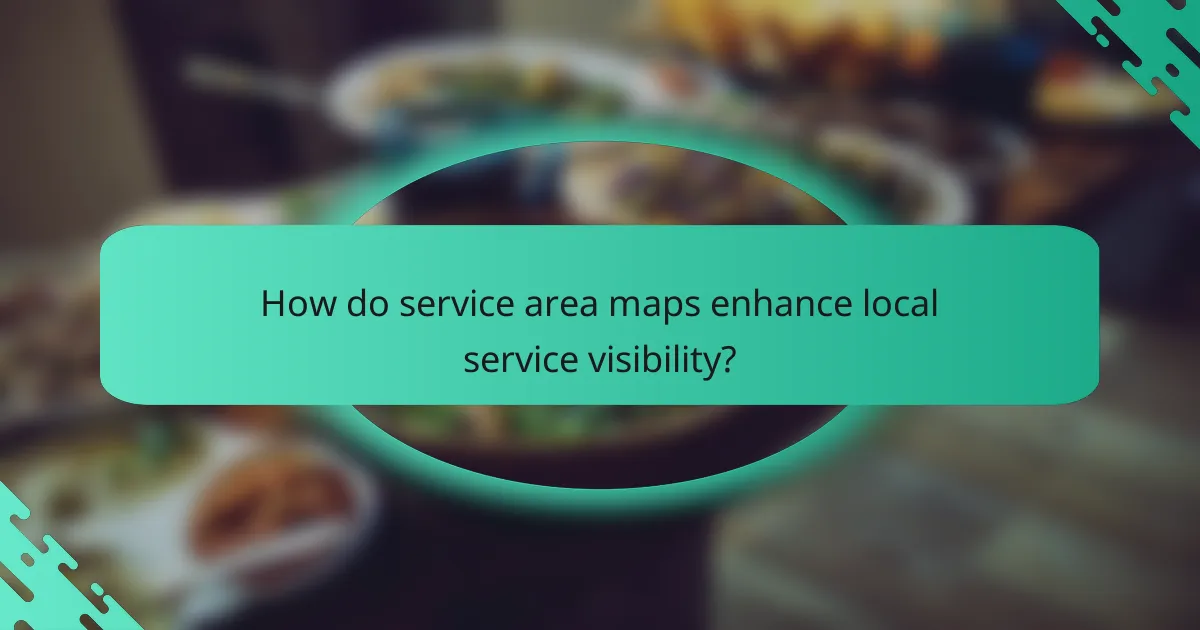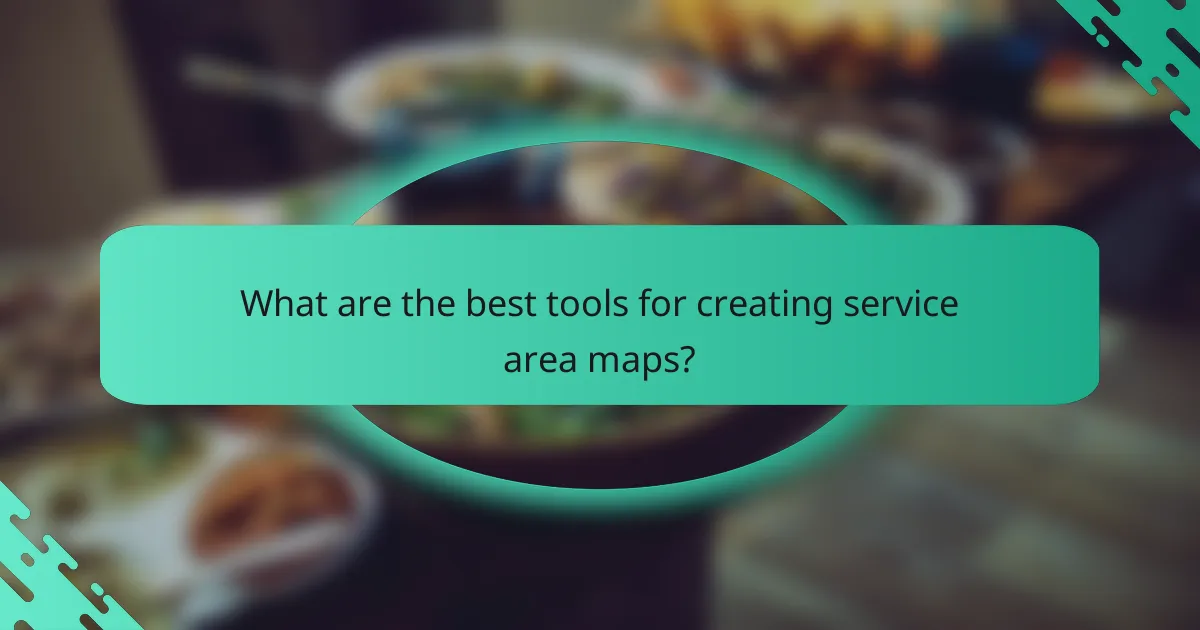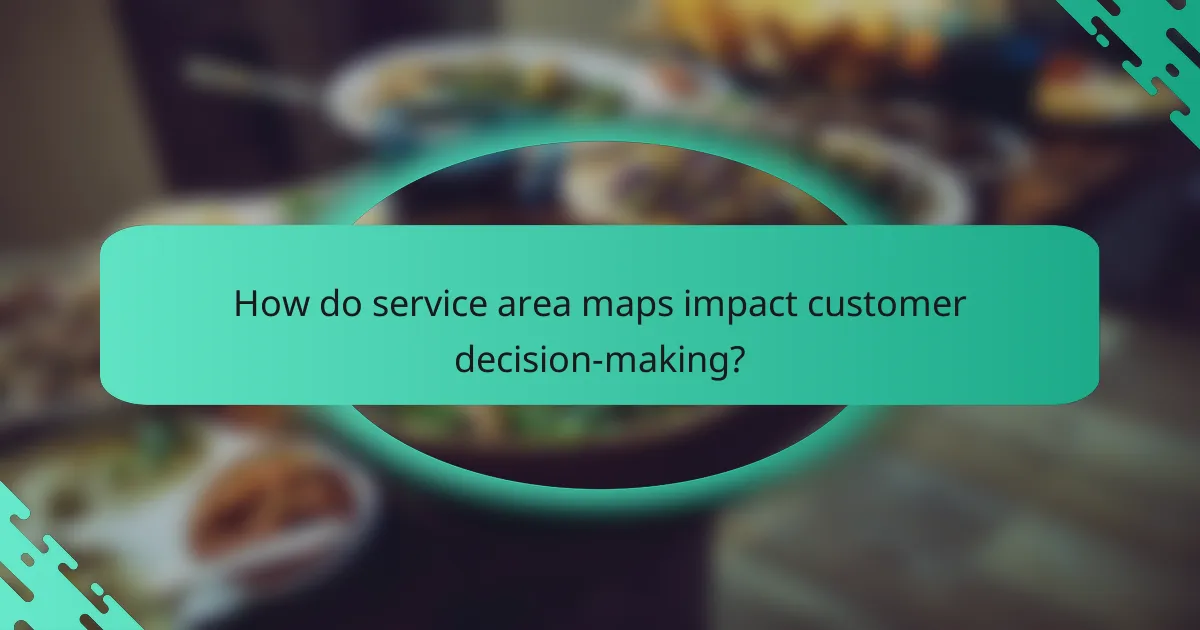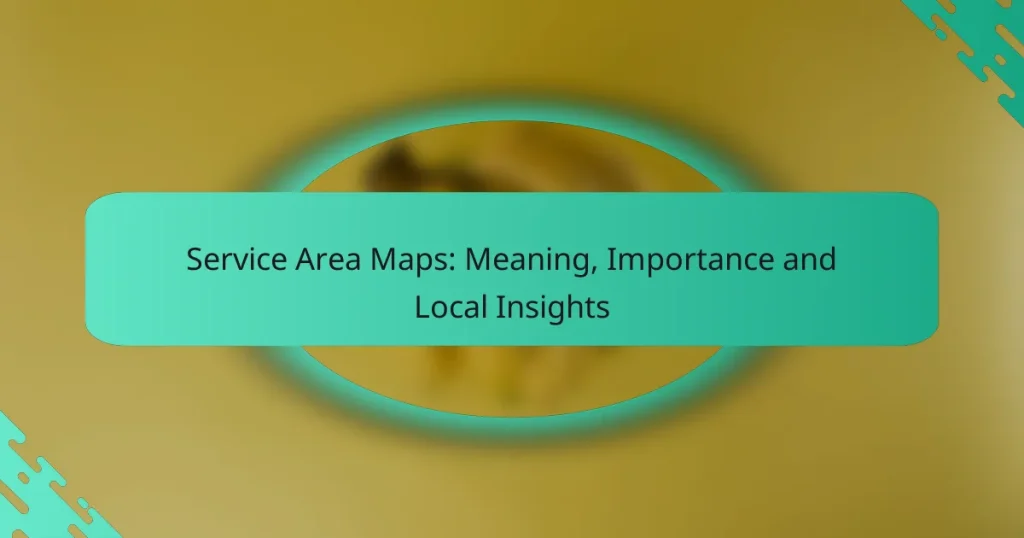Service area maps play a vital role in enhancing a business’s visibility by clearly outlining the geographic regions where services are offered. By providing potential customers with a visual representation of service availability, these maps not only increase awareness but also help businesses optimize their operations and marketing strategies.

How do service area maps enhance local service visibility?
Service area maps significantly enhance local service visibility by clearly defining the geographic regions where a business operates. This clarity helps potential customers understand service availability, leading to increased awareness and engagement.
Improved local SEO rankings
Service area maps contribute to improved local SEO rankings by optimizing a business’s online presence in specific geographic locations. By including relevant keywords and location data, businesses can rank higher in local search results, making it easier for customers to find them.
To maximize this effect, ensure that service area maps are integrated into your website’s content and metadata. Regularly updating these maps can also signal to search engines that your business is active and relevant in your service areas.
Targeted marketing strategies
With service area maps, businesses can develop targeted marketing strategies that resonate with local audiences. By analyzing the demographics and preferences of customers in specific areas, companies can tailor their promotions and advertising efforts to meet local needs.
For example, a landscaping service might focus on seasonal promotions in regions with distinct climates, while a delivery service can highlight speed and reliability in urban areas. This localized approach often results in higher conversion rates and customer loyalty.
Increased customer engagement
Service area maps lead to increased customer engagement by providing clear information about service availability. When customers can easily see if a business serves their area, they are more likely to reach out for inquiries or make purchases.
Additionally, businesses can use service area maps in their communication strategies, such as social media posts or email campaigns, to highlight specific services available in certain regions. This targeted communication fosters a sense of connection and relevance with local customers.

What is the importance of service area maps for businesses?
Service area maps are crucial for businesses as they visually define the geographic regions where services are offered. These maps help companies understand their market reach, optimize operations, and effectively target their marketing efforts.
Defining service boundaries
Defining service boundaries is essential for businesses to clarify where they can provide services. This helps prevent overextension and ensures that resources are allocated efficiently. For example, a delivery service may limit its operations to a specific radius around its location to maintain timely deliveries.
When establishing these boundaries, consider factors such as transportation routes, local regulations, and competition. Mapping tools can assist in visualizing these areas, making it easier to adjust as needed based on demand or operational changes.
Identifying customer demographics
Identifying customer demographics within service areas allows businesses to tailor their offerings to meet local needs. Understanding the age, income, and preferences of potential customers can guide product development and marketing strategies. For instance, a fitness center might focus on younger demographics in urban areas while offering family-friendly programs in suburban regions.
Utilizing data analytics tools can enhance demographic insights, enabling businesses to refine their target audience and improve customer engagement. Regularly updating this information ensures that strategies remain relevant as community dynamics evolve.
Optimizing resource allocation
Optimizing resource allocation is vital for maximizing efficiency and minimizing costs. By analyzing service area maps, businesses can determine where to allocate staff, inventory, and equipment most effectively. For example, a plumbing company might concentrate its technicians in areas with higher service requests to reduce travel time and improve response rates.
Additionally, businesses should regularly assess their service areas to identify trends and adjust their resource distribution accordingly. This proactive approach helps maintain service quality and customer satisfaction while keeping operational costs in check.

How can businesses create effective service area maps?
Businesses can create effective service area maps by utilizing mapping software, incorporating customer data, and regularly updating their maps. These strategies ensure that the maps accurately reflect the areas served and help in optimizing service delivery.
Utilizing mapping software
Mapping software allows businesses to visually represent their service areas with precision. Tools like Google Maps, Mapbox, or specialized GIS software can help in creating detailed and interactive maps that highlight coverage zones.
When selecting mapping software, consider features such as ease of use, customization options, and integration capabilities with other business systems. A user-friendly interface can significantly reduce the time needed to create and update maps.
Incorporating customer data
Incorporating customer data is crucial for creating relevant service area maps. By analyzing customer locations and demographics, businesses can identify high-demand areas and tailor their services accordingly.
Utilize customer relationship management (CRM) systems to gather and visualize data. This approach helps in pinpointing where to focus marketing efforts and resource allocation, ensuring that services reach the right audience effectively.
Regularly updating maps
Regularly updating service area maps is essential to reflect changes in business operations or customer demographics. This practice ensures that the maps remain accurate and relevant over time.
Set a schedule for reviews, such as quarterly or biannually, to assess and modify the maps based on new data or shifts in service capabilities. Failing to update maps can lead to inefficient service delivery and customer dissatisfaction.

What are the best tools for creating service area maps?
The best tools for creating service area maps include Google My Business, Mapbox, and ArcGIS. Each of these platforms offers unique features that cater to different needs, from simple visualizations to complex geographic analyses.
Google My Business
Google My Business (GMB) is a user-friendly tool that allows businesses to define their service areas directly on their Google Maps listing. This feature helps local customers find services within a specified radius, enhancing visibility and accessibility.
To create a service area map with GMB, simply log into your account, navigate to the “Info” section, and set your service area by entering specific locations or drawing a radius on the map. This ensures your business appears in relevant local searches.
Mapbox
Mapbox is a versatile mapping platform that provides advanced customization options for creating detailed service area maps. It is particularly useful for businesses needing interactive maps that can be embedded on websites or applications.
With Mapbox, users can utilize its APIs to create dynamic maps that reflect real-time data. Consider using its features to visualize service areas based on customer demographics or geographic trends, which can enhance strategic planning.
ArcGIS
ArcGIS is a powerful geographic information system (GIS) tool that allows for in-depth analysis and visualization of service areas. It is ideal for organizations that require detailed spatial analysis and integration with other data sources.
To create a service area map in ArcGIS, you can use its various analytical tools to assess factors like population density and accessibility. This can help in making informed decisions about service expansion or resource allocation. However, be aware that ArcGIS may require a steeper learning curve and a subscription fee compared to other tools.

How do service area maps impact customer decision-making?
Service area maps significantly influence customer decision-making by visually representing the geographical reach of a business. These maps help potential customers quickly assess whether a service is available in their location, which can directly affect their choice to engage with a company.
Visualizing service reach
Service area maps provide a clear visual representation of where services are offered, allowing customers to easily identify if they fall within the coverage zone. This is particularly important for businesses like delivery services, home repair, or healthcare providers, where geographic limitations can determine accessibility.
For example, a local plumbing company might use a service area map to show neighborhoods they serve. Customers can quickly see if their address is included, reducing uncertainty and streamlining the decision-making process.
Enhancing trust and credibility
Displaying a well-defined service area can enhance a business’s trustworthiness and credibility. When customers see a transparent map indicating the areas served, they are more likely to feel confident that the business is reliable and professional.
Moreover, clear service area maps can help prevent misunderstandings about service availability, which can lead to customer dissatisfaction. Businesses should ensure that their maps are up-to-date and accurately reflect their current service capabilities to maintain trust.

What are common challenges in using service area maps?
Service area maps often face challenges related to data accuracy and the complexity of updates. These issues can lead to misinterpretations and inefficiencies in service delivery.
Data accuracy issues
Data accuracy is crucial for effective service area maps, as incorrect information can mislead users and affect decision-making. Factors such as outdated data sources, human error in data entry, and changes in local regulations can contribute to inaccuracies.
To mitigate these issues, regularly verify data against reliable sources and consider using automated systems that can update information in real-time. For instance, businesses should cross-check service area boundaries with local zoning laws and demographic data to ensure alignment.
Complexity in updates
Updating service area maps can be complex due to the need for continuous monitoring of changes in service offerings, geographic boundaries, and customer needs. This complexity can lead to delays in implementing necessary adjustments, which may affect service efficiency.
To streamline updates, establish a routine review process and utilize mapping software that allows for easy modifications. Additionally, training staff on the importance of timely updates can help maintain the accuracy and relevance of service area maps.


